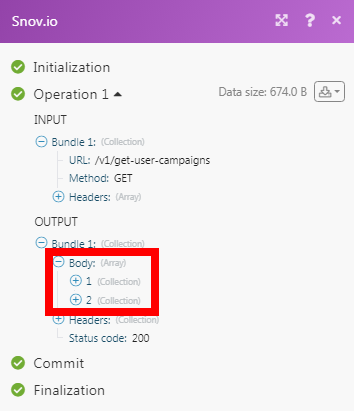| Contact us |
|---|
| We are preparing the connectionUnique, active service acces point to a network. There are different types of connections (API key, Oauth…). More with this application for you. In the meantime, please create your own connection. |
The Snov.io modulesThe module is an application or tool within the Boost.space system. The entire system is built on this concept of modularity. (module - Contacts) More allow you to monitor, create, update, and search the prospects, and emails in your Snov.io account.
Prerequisites
-
A Snov.io account
In order to use Snov.io with Boost.spaceCentralization and synchronization platform, where you can organize and manage your data. More IntegratorPart of the Boost.space system, where you can create your connections and automate your processes. More, it is necessary to have a Snov.io account. If you do not have one, you can create a Snov.io account at snov.io.
![[Note]](https://bs-docs2.boost.space/wp-content/themes/bsdocs/docs-parser/HTML/css/image/note.png) |
Note |
|---|---|
|
The moduleThe module is an application or tool within the Boost.space system. The entire system is built on this concept of modularity. (module - Contacts) More dialog fields that are displayed in bold (in the Boost.space Integrator scenarioA specific connection between applications in which data can be transferred. Two types of scenarios: active/inactive. More, not in this documentation article) are mandatory! |
To connect your Snov.io account to Boost.space Integrator you need to obtain the API Key from your Snov.io account and insert it in the Create a connection dialog in the Boost.space Integrator
1. Log in to your Snov.io account.
2. Click your Profile Icon > Account > API.
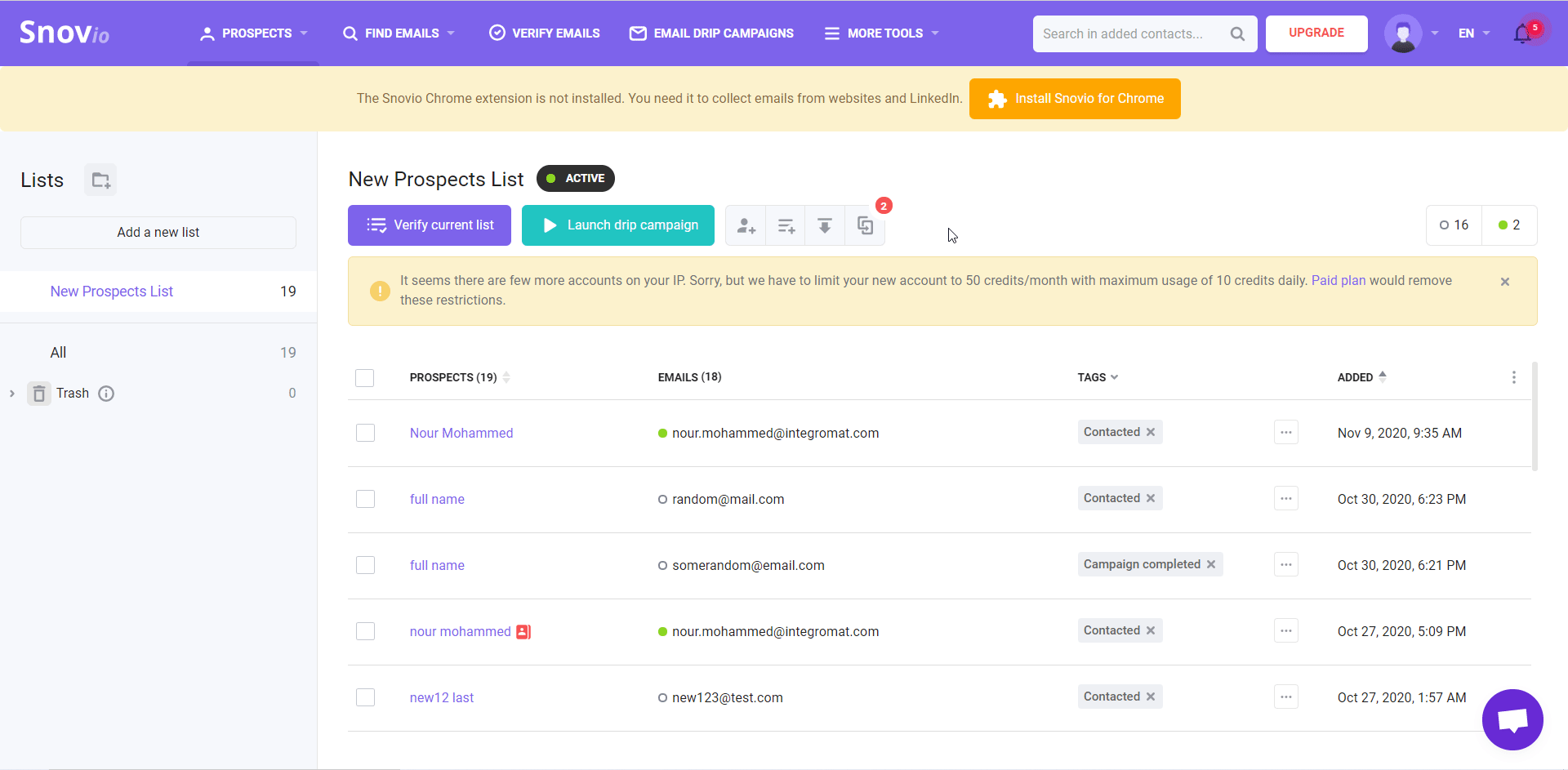
3. Copy the API UserCan use the system on a limited basis based on the rights assigned by the admin. More ID and API Secret to a safe place.
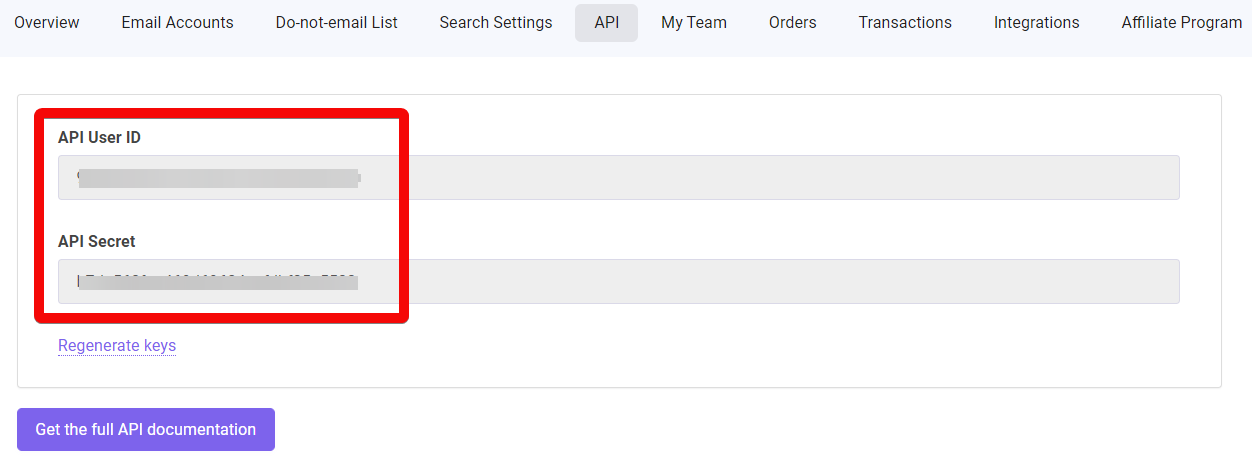
4. Go to Boost.space Integrator and open the Snov.io module’s Create a connection dialog.
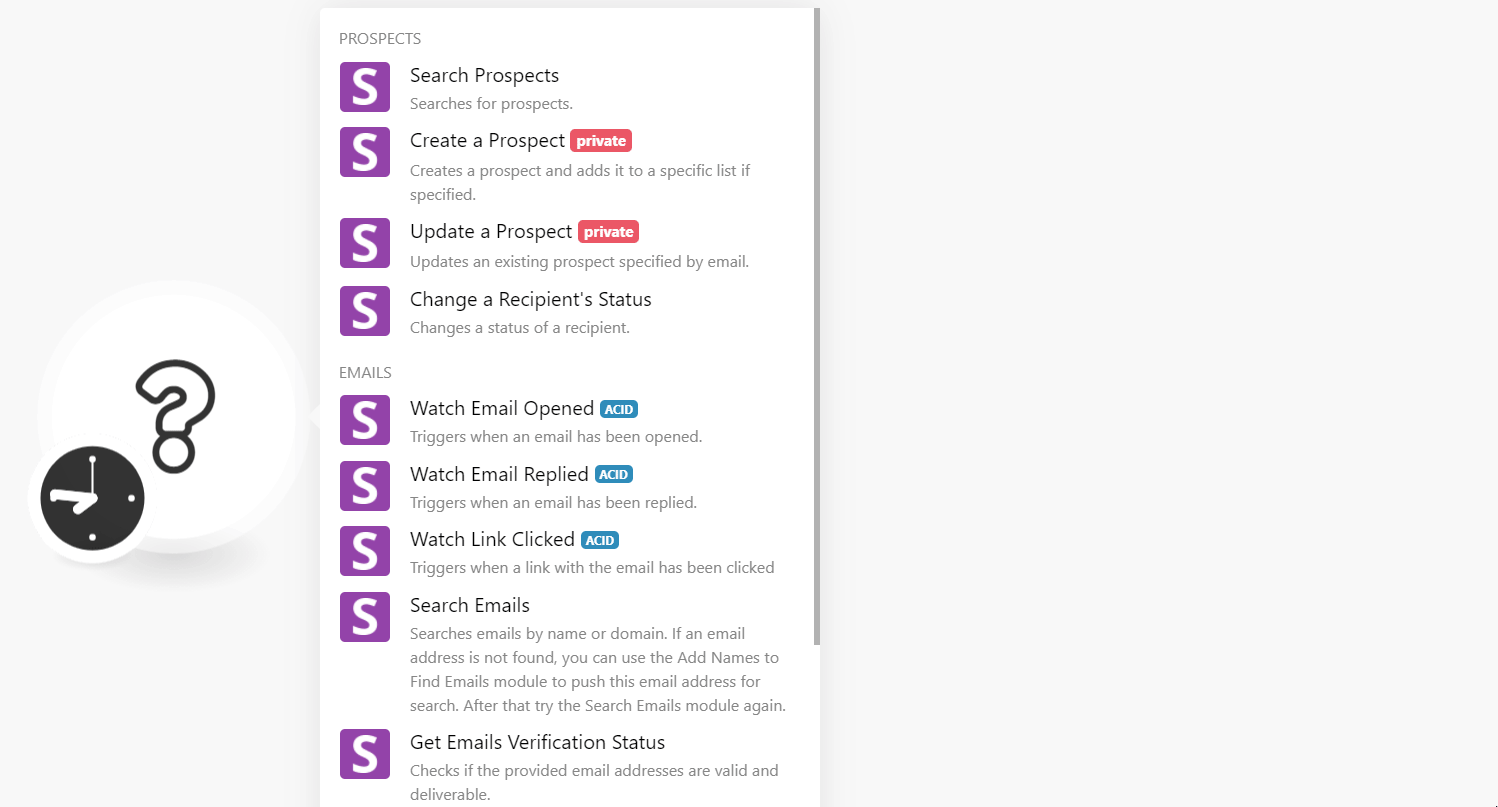
5. In the Connection name field, enter a name for the connection.
6. In the API User ID and API Secret fields, enter the API details copied in step 3 and click Continue.
The connection has been established.
Searches for prospects.
|
Connection |
|
|
Search Type |
Select the option to search the prospect:
|
|
List ID |
Select or map the List ID to search prospects from the specified ID. |
|
|
Select or map the email address of the prospect you are searching for. |
|
Prospect ID |
Select or map the Prospect ID of the prospect you are searching for. |
|
Limit |
Set the maximum number of prospects Boost.space Integrator should return during one execution cycleA cycle is the operation and commit/rollback phases of scenario execution. A scenario may have one or more cycles (one is the default).. |
Changes statusCreate statuses for each module separately to create an ideal environment for efficient and consistent work. More of a recipient.
|
Connection |
|
|
List ID |
Select or map the List ID whose prospect |
|
|
Select or map the prospect’s email address. |
|
Campaign ID |
Select or map the Campaign ID prospect’s |
|
Status |
Select or map the status:
|
TriggersEvery scenario has a trigger, an event that starts your scenario. A scenario must have a trigger. There can only be one trigger for each scenario. When you create a new scenario, the first module you choose is your trigger for that scenario. Create a trigger by clicking on the empty module of a newly created scenario or moving the... when an email has been opened.
|
Connection |
|
|
Campaign ID |
Select or map the Campaign ID whose opened emails you want to watch. |
|
Limit |
Set the maximum number of opened emails Boost.space Integrator should return during one execution cycle. |
Triggers when an email has been replied to.
|
Connection |
|
|
Campaign ID |
Select or map the Campaign ID whose email replies you want to watch. |
|
Limit |
Set the maximum number of email replies Boost.space Integrator should return during one execution cycle. |
Triggers when a link with the email has been clicked.
|
Connection |
|
|
Campaign ID |
Select or map the Campaign ID whose email clicks you want to watch. |
|
Limit |
Set the maximum number of links clicked Boost.space Integrator should return during one execution cycle. |
Searches emails by name or domain. If an email address is not found, you
|
Connection |
|
|
First Name |
Enter the email address owner’s first name whose emails you want to search. |
|
Last Name |
Enter the email address owner’s last name whose emails you want to search. |
|
Domain |
Enter the domain of the email address you want to search. For example, |
|
Limit |
Set the maximum number of emails Boost.space Integrator should return during one execution cycle. |
Checks if the provided email addresses are valid and deliverable.
|
Connection |
|
|
Emails |
Add the email address whose verification status you want to retrieve. |
Adds a list of email addresses you need to add to the verification queue.
|
Connection |
|
|
Emails |
Add the email address you want to add to the verification queue. |
Pushes the request for email search using this method. If an email is found. If an email is found, you can collect it by using the Search Emails request again.
|
Connection |
|
|
First Name |
Enter the email address owner’s first name to add to the emails. |
|
Last Name |
Enter the email address owner’s last name. |
|
Domain |
Enter the domain of the email address. For example, |
Performs an arbitrary authorized API call.
|
Connection |
||||
|
URL |
Enter a path relative to
|
|||
|
Method |
Select the HTTP method you want to use: GET to retrieve information for an entry. POST to create a new entry. PUT to update/replace an existing entry. PATCH to make a partial entry update. DELETE to delete an entry. |
|||
|
Headers |
Enter the desired request headers. You don’t have to add authorization headers; we already did that for you. |
|||
|
Query String |
Enter the request query string. |
|||
|
Body |
Enter the body content for your API call. |
The following API call returns all the campaigns from your Snov.io account:
URL: /v1/get-user-campaigns
Method: GET
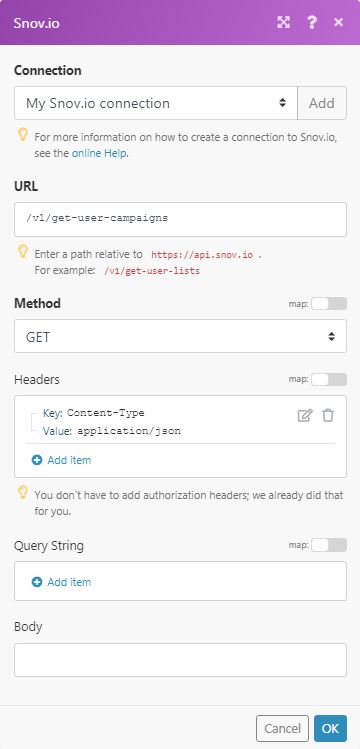
Matches of the search can be found in the module’s Output under BundleA bundle is a chunk of data and the basic unit for use with modules. A bundle consists of items, similar to how a bag may contain separate, individual items. More > Body. In our example, 2 campaigns were returned:
